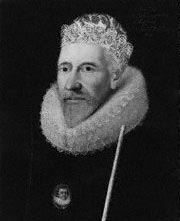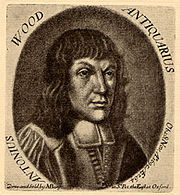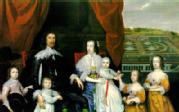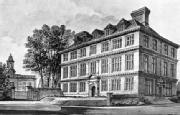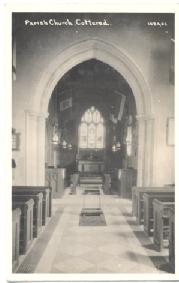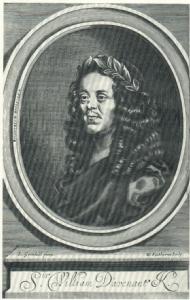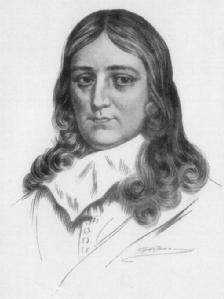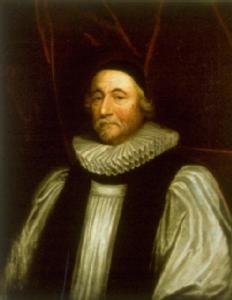Biography
Hester Pulter (1605-1678) was the daughter of Sir James Ley, the first Earl of Marlborough (1550-1629) and his wife Mary née Petty of Stoke Talmage in Oxfordshire (d. 1613). Pulter was born just outside Dublin during June 1605, following her father’s appointment as chief justice of the king’s bench in Ireland (‘The Declaracion of Ley’). It is most likely that the family left Ireland in 1608 when Pulter’s father returned to England by royal command. In 1624 Ley was made lord treasurer and in 1626 he was elevated to the peerage, becoming the first earl of Marlborough. As a statesman, James Ley’s contemporary reputation was somewhat dubious but he was noted for his knowledge of law and antiquaries (ODNB). Pulter’s mother came from a prominent Oxfordshire family and was the niece of George Pettie (c.1548–1589), the writer of romances, whose best-known work A Petite Pallace of Pettie his Pleasure (c. 1576) was reprinted several times during the late-sixteenth and early-seventeenth centuries. She was also the aunt of Anthony Wood (1632–1695), the well-known Oxford antiquary (Clark (1891) p. 32-7). Pulter was one of eleven surviving children; Henry (later the second Earl of Marlborough), James (who died aged eighteen fighting for the king in the Dutch Wars), William (the fourth Earl of Marlborough following the death of Henry's son James), Elizabeth, Anne, Mary, Dionysia, Margaret, Martha and Phoebe (Burke, p. 313).
In 1618, aged thirteen, Hester married Arthur Pulter (1603-1689), son of Lytton Pulter (1575–1626) and Penelope Capel (1581–1611) of Hadham Hall Hertfordshire. Very little is known about Arthur; in 1641 he was made sheriff of Hertfordshire but at the onset of the Civil Wars he retired from public service and ‘thro’ the Importunity of his Wife’ he devoted himself to building their manor house, Bradfield or Broadfield, also in Hertfordshire (Chauncy, p. 145). It is here that Pulter appears to have composed most of her poetry and in several of her poems she complains that she is ‘shut up in a Countrey Grange’, although tantalisingly she declines to reveal why this is the case (MS Lt q 32, f. 79r). The Hertfordshire landscape provides a back-drop for much Pulter’s of poetry in which, in addition to referencing her own house and garden, she mentions local rivers, such as the Been, the Colne and Lea; landmarks, including Gray’s Spring and the ruins of the ancient Roman city of Verulamium; and also the annual fair held in the neighbouring village of Baldock (ff. 6r+97v). One significant reason for Pulter’s sense of imprisonment may have been the periods of confinement associated with childbirth. Between 1624 and 1648 she gave birth to a total of fifteen children, only two of whom survived her. It is therefore unsurprising that many of her poems, such as the exhaustingly titled ‘Universall dissolution, made when I was with Child of my 15th Child \my sonne John/ I being as every one thought in a Consumption 1648’, address the births and deaths of individual children (f.10v). In opposition to contemporary conventions regulating the expression of maternal grief, Pulter uses her poetry to express her extreme sadness and sense of loss, particularly relating to the deaths of her teenaged daughters, Jane (1624-1645) and Penelope (b.1633). Only her daughter Margaret (1629-1686), who later married John Forester, a London merchant, lived to have children of her own. Her son James (1660-1696) was the sole heir the to family estate.
Within Pulter’s literary manuscript, dates provided for several of the occasional poems, together with references to specific contemporary events, suggest they were composed during the 1640s amidst the turbulence of the Civil Wars. Her emblem poems include references to the ‘Protector’, a position held by Oliver Cromwell between 1653 and 1658, and to events and printed texts from the mid-to-late 1650s suggesting that they were composed during the later years of the Interregnum. Pulter, a staunch and well-read royalist, used her poetry to engage with contemporary, particularly political, literary culture. In addition to elegies mourning the regicide are poems contributing to the flurry of manuscript and printed texts occasioned by the deaths in 1648 of Sir Charles Lucas and Sir George Lisle and an uncharacteristically saucy poem ridiculing the Sir William Davenant (whom Pulter states she has not met) for the loss of his nose through syphilis. Pulter’s family featured several prominent royalists including her nephew James, later the third Earl of Marlborough, who fought for the king during the first civil war and who died at the battle of Lowestoft in 1665, an event recounted in Marvell's 'The Second Advice to a Painter'. In 1680 a copy of his supposed deathbed repentance, in which he provides an account of his religious views, was published alongside that of the notorious libertine John Wilmot, 2nd Earl of Rochester (1647–1680). The most well known of Pulter’s royalist relatives was Sir Arthur Capel (her husband’s first cousin) who had been opposed to Charles’ personal rule but, following his elevation to peerage in 1641, had opted to fight for the king. Capel was captured and then executed by the parliament shortly after the regicide in 1649. Pulter remembers her ‘Heroick Kinsman’ in a poem mourning the death of Charles I, in which she states that the family’s personal grief has been overwhelmed by their sorrow at the loss of the king (f. 34v).
It would appear, however, that the majority of Pulter’s closest relatives were in active opposition to the king. Her sister, Margaret (d.1652) married James Hobson a Lieutenant-Colonel in the Westminster regiment of the parliamentarian army. During the early years of the 1640s the couple, then living in Aldersgate St in London, were close neighbours and friends of John Milton (Darbishire, p. 64). It was during this time that he composed his sonnet ‘To the Lady Margaret Ley’ in which he compares the Earl of Marlborough with Isocrates ‘that old man eloquent’ and praises Margaret for possessing her dead father’s ‘noble virtues’. A third sister, Dionysia (d. 1674), married the MP and diarist John Harington of Kelston (1588/9–1654) and it his diary which, outside of her literary manuscript, provides the most substantial information about Pulter’s life (Steig, 1977). Portions of the diary are extant for 1646–1653 and they reveal that she belonged to a close-knit family whose kinship ties apparently transcended the political divisions of the Civil Wars. Despite supporting the parliamentarian cause early in the civil wars, Harington was primarily a moderate who had, following Pride’s purge of parliament in 1648, retired from public duty (ODNB). He notes frequent meetings with parliamentarian family members such James Hobson but he also records accompanying his wife on a trip to Broadfield, presumably to visit the Pulters. When Margaret Hobson died in 1652 it was Pulter, on a three-week visit to London, who informed Harington of her death, having received the news in a letter from the bereaved Captain Hobson. During this visit to the capital, Pulter paid a visit to the home of Harington’s associate Sir Samuel Browne (1598-1668) where she conversed in the library with James Ussher, Archbishop of Armargh (1581-1656). Throughout the Civil Wars Browne was a political and religious moderate belonging to a group which has been described as the ‘royal Independents’. He retired from public duty in 1648 following the failure of the peace negotiations with the king (ODNB). Ussher, like both Harington and Browne, was renowned for his exceptional learning and, although he professed loyalty to the Stuart monarchy, was widely respected by people on both sides of the political divide (ODNB). Pulter’s visit to London suggests that by 1652 her confinement at Broadfield had come to an end. It also indicates that despite the vehement royalist message of her poetry she was freely associating with men who had once actively served the parliamentarian cause in opposition to Charles I.
While Pulter is particularly forthright about her political affiliations her religious views are more difficult to determine. Her writing suggests that they were somewhat unusual for the period but does not provide any sense of a coherent theological basis for her beliefs. She does not enter into the religious disputes which contributed to the civil wars but she does reject a strict understanding of the doctrine of predestination, therefore distancing herself from the Puritanism practiced by associates such as Harington. It is also likely that she absented herself from services at Cottered parish church where her husband was the patron of the radical rector Thomas Gardiner (Ross, p. 145). But her attacks on puritan iconoclasm are predominantly political and class-conscious criticisms of the parliamentarian army and there are no suggestions that she was interested in issues of church government or ceremony. It seems that Pulter’s attitude to the civil wars and Interregnum was primarily determined by social conservatism, not religious conviction. She lived to see the Restoration and was buried on the 9th April 1678 in Cottered church, not far from Broadfield Manor.
This summary of Pulter's life is based on Chapter One of Alice Eardley ‘An Edition of Lady Hester Pulter’s “Emblemes”’ (Unpublished PhD Thesis: University of Warwick, 2008)
See also Mark Robson, ‘Pulter, Lady Hester (1595/6–1678)’, Oxford Dictionary of National Biography (Oxford University Press, 2004)
Texts Cited
Leeds Brotherton, MS Lt q 32 (Hester Pulter's literary manuscript)
Wiltshire and Swindon Record Office, 366/1 (Declaracion of Ley)
John Burke and Bernard Burke, A Genealogical and Heraldic History of the Extinct and Dormant Baronetcies of England, Ireland and Scotland 2nd Edition (London: J.R. Smith, 1844)
Henry Chauncy, The Historical Antiquities of Hertfordshire 2nd Edition (Dorking: Kohler and Coombes, 1975), vol. 1
A. Clark ed., The Life and Times of Anthony Wood, 1, OHS, 19 (1891)
Edward Phillips, The Early Lives of Milton ed. Helen Darbishire.
Sarah Ross, 'Women and Religious Verse in English Manuscript Culture, c. 1600 - 1668: Lady Anne Southwell, Lady Hester Pulter and Katherine Austen' (Oxford: D. Phil Thesis, 2000).
Margaret Stieg ed., The Diary of John Harington, M.P (Yeovil: Somerset Record Society, 1977)

